 \\
\\Trouble Shooter
More often than not, space ships are developers’ vehicle of choice for players to pilot when it comes to shoot ‘em ups. When Vic Tokai were working on Trouble Shooter (known as Battle Mania in Japan), the studio had other plans, as they opted for a pair of anime girls with jet packs and blasters. From it’s silly story to its cartoony art style, it was a very lighthearted title that managed to set itself apart from a lot of other shmups to come out in the early 90s.Unlike a lot of games from that period that had players rescuing princesses from super villains, Trouble Shooter decided to change things up by having a couple of teenage girls, named Madison and Crystal, rescue a prince who had been kidnapped. It’s a super simple concept that’s carried by brief, conversation-heavy cut scenes between stages. Each of the characters have a lot of personality, which makes them interesting, and one can tell from the onset that the game isn’t taking itself at all seriously.
Before starting a stage, players get to choose from a small selection of special weapons before they’re off to blast some robots. In each stage, players control both girls at once as they fly through each level. Madison takes the lead when using the direction pad, with Crystal following automatically. Crystal can also be commanded to shoot either forward or backward, allowing for concentrated fire up front when there are a lot of enemies in the way, or covering the team’s rear when baddies are trying to sneak up from behind. Then there’s the special weapon players select at the beginning of the stage, which include things like saturating the screen with rockets or electricity attacks.
Trouble Shooter isn’t a very hard game. While players don’t get lives, instead Madison will have a hit point pool. Once it’s exhausted, the game over screen appears and players will have a few continues that they can use to progress. The hit points aren’t strictly fixed, either. Throughout the stages, little heart icons can be found and if Madison flies over it, she’ll be able to take an extra hit before dying. If players are good, they’ll be able to stack quite a few of these if they dodge everything enemies shoot at them, resulting in a very deep hit point pool that would require a colossal screw up in order to ruin. Also, while Madison can take damage, Crystal does not. This allows players to act more strategically, trying to put Crystal in dangerous areas while Madison is hopefully further back in relative safety.
This leaves most of the major tough spots that the game throws at players more as little Gotcha! moments that players just need to make a mental note of avoiding in future playthroughs. Most enemies and even bosses are pretty easy to deal with, especially when one realizes that most of the bullets that they shoot at the girls can actually be destroyed with the player’s weapon fire.
Each of the stages has quite a bit of detail for a Mega Drive game. The environments have all sorts of things going on with little touches tossed in everywhere. On particular standout is the trains going by in the background of the first level where the developers even made a point of including a “kachunk-kachunk, kachunk-kachunk” sound effect of the train going along the tracks. The areas where the visuals really shine, though, are the enemy and character designs. Madison and Crystal spend a lot of time blasting their way through hordes of robots, and they have a tendency to be very cartoony with big, mean-looking eyes, gritted teeth, quite intent on doing the girls harm. The bosses in particular can be very silly. Everything about the characters in this game feel like something that should be in a comedy anime.
The soundtrack also contributes to this feeling that the game could work just as well as a silly, weekly anime. There are a number of tunes that add quite a bit to already humorous situations. Meanwhile, the music playing while fighting one’s way through each level is quite catchy and fitting for the environments as well.
Looking back at shoot ‘em ups in the 80s and 90s, there were no lack of entries that had players zipping around in space ships. Trouble Shooter's insistence on trying to do things differently is quite refreshing. From having girls in jet packs, to enjoyable combat, to a lighthearted, cartoony story and design aesthetic, the game is a nice change of pace for those interested in a shmup, but want something that stands out from the crowd a bit.
- IroIro
April 24, 2019
Publisher: Vic Tokai
Genre: Shoot 'Em Up
Platform: Genesis / Mega Drive
Released: 1991
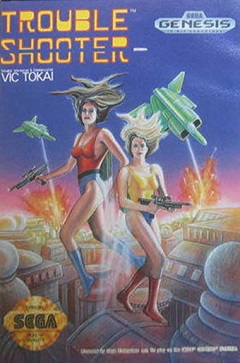
Genesis cover art
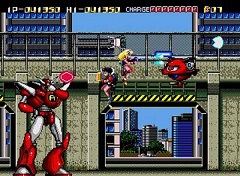
First boss
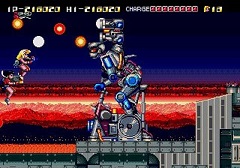
There are a number of imaginitive bosses in the game
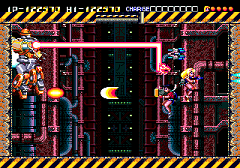
Construction boss
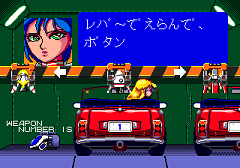
Weapon select screen